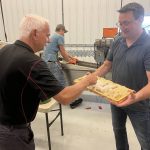
Getting industries on the same page
Southern Alberta farmer making his way into world of technological software with new app for pollinators

Alberta honey business ‘thrives’ despite bumpy beginnings
Thrive Honey shows synergy using the power of bees for honey making and agriculture pollination

Pollinators play a crucial role in Alberta
Beelieve it? Bees of all kinds play a crucial role in Alberta’s economy and landscape

COMMENT: How honeybees can help us monitor pollution across Canada

Weighing the benefit-risk balance on field edges
Researchers hope to weigh both agricultural value and risk from field boundaries like ditches and shelterbelts

Neonicotinoids, reducing bee mortality are priorities for new research chair
Bees produce billions in benefits for Prairie farmers but they face a host of challenges

Washington state eradicates first ‘murder hornet’ nest of the year
Nest found in northwestern county near B.C. border

Native pollinators want to be your buddies
Some simple things can make your land more attractive to pollinators

Bees cannot live on canola and alfalfa alone
‘Agriculture blooms for one month a year’ and so maintaining pockets of natural food sources is critical
Reading Time: 2 minutes Cropland’s encroachment on nature threatens to starve bees and pollinators, says beekeeper Ian Steppler. “Where we find a balance within our countryside between agriculture and nature is where we find tremendous growth and prosperity,” said Steppler, a crops and cattle producer in Manitoba who has 1,500 hives and produces over 250,000 pounds of honey per […] Read more
Environmental threats put bumblebee queens under pressure
Insecticide exposure and declining floral diversity are jeopardizing key pollinator group

